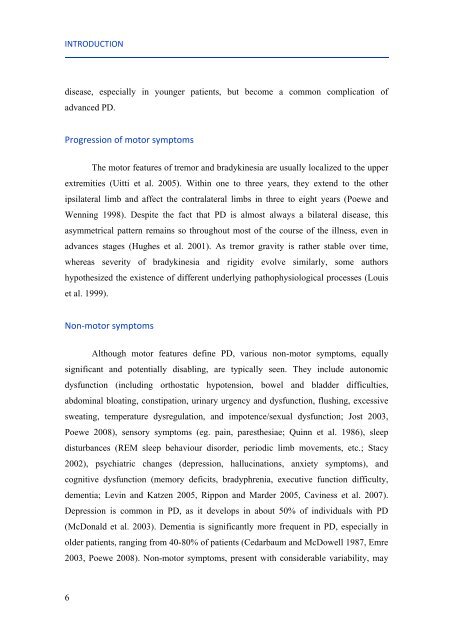Mechanisms of aluminium neurotoxicity in oxidative stress-induced ...
Mechanisms of aluminium neurotoxicity in oxidative stress-induced ...
Mechanisms of aluminium neurotoxicity in oxidative stress-induced ...
Create successful ePaper yourself
Turn your PDF publications into a flip-book with our unique Google optimized e-Paper software.
INTRODUCTION<br />
disease, especially <strong>in</strong> younger patients, but become a common complication <strong>of</strong><br />
advanced PD.<br />
Progression <strong>of</strong> motor symptoms<br />
6<br />
The motor features <strong>of</strong> tremor and bradyk<strong>in</strong>esia are usually localized to the upper<br />
extremities (Uitti et al. 2005). With<strong>in</strong> one to three years, they extend to the other<br />
ipsilateral limb and affect the contralateral limbs <strong>in</strong> three to eight years (Poewe and<br />
Wenn<strong>in</strong>g 1998). Despite the fact that PD is almost always a bilateral disease, this<br />
asymmetrical pattern rema<strong>in</strong>s so throughout most <strong>of</strong> the course <strong>of</strong> the illness, even <strong>in</strong><br />
advances stages (Hughes et al. 2001). As tremor gravity is rather stable over time,<br />
whereas severity <strong>of</strong> bradyk<strong>in</strong>esia and rigidity evolve similarly, some authors<br />
hypothesized the existence <strong>of</strong> different underly<strong>in</strong>g pathophysiological processes (Louis<br />
et al. 1999).<br />
Non-motor symptoms<br />
Although motor features def<strong>in</strong>e PD, various non-motor symptoms, equally<br />
significant and potentially disabl<strong>in</strong>g, are typically seen. They <strong>in</strong>clude autonomic<br />
dysfunction (<strong>in</strong>clud<strong>in</strong>g orthostatic hypotension, bowel and bladder difficulties,<br />
abdom<strong>in</strong>al bloat<strong>in</strong>g, constipation, ur<strong>in</strong>ary urgency and dysfunction, flush<strong>in</strong>g, excessive<br />
sweat<strong>in</strong>g, temperature dysregulation, and impotence/sexual dysfunction; Jost 2003,<br />
Poewe 2008), sensory symptoms (eg. pa<strong>in</strong>, paresthesiae; Qu<strong>in</strong>n et al. 1986), sleep<br />
disturbances (REM sleep behaviour disorder, periodic limb movements, etc.; Stacy<br />
2002), psychiatric changes (depression, halluc<strong>in</strong>ations, anxiety symptoms), and<br />
cognitive dysfunction (memory deficits, bradyphrenia, executive function difficulty,<br />
dementia; Lev<strong>in</strong> and Katzen 2005, Rippon and Marder 2005, Cav<strong>in</strong>ess et al. 2007).<br />
Depression is common <strong>in</strong> PD, as it develops <strong>in</strong> about 50% <strong>of</strong> <strong>in</strong>dividuals with PD<br />
(McDonald et al. 2003). Dementia is significantly more frequent <strong>in</strong> PD, especially <strong>in</strong><br />
older patients, rang<strong>in</strong>g from 40-80% <strong>of</strong> patients (Cedarbaum and McDowell 1987, Emre<br />
2003, Poewe 2008). Non-motor symptoms, present with considerable variability, may

















